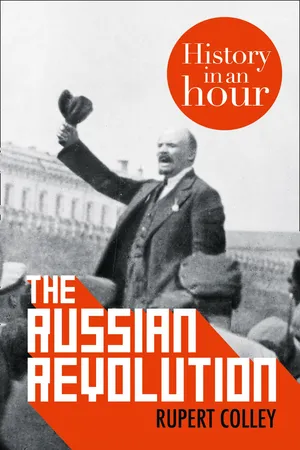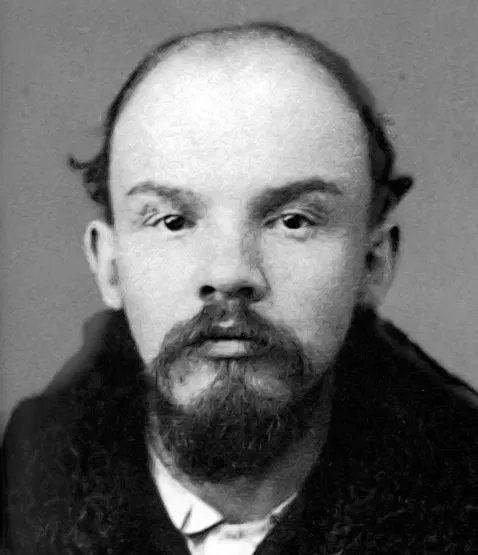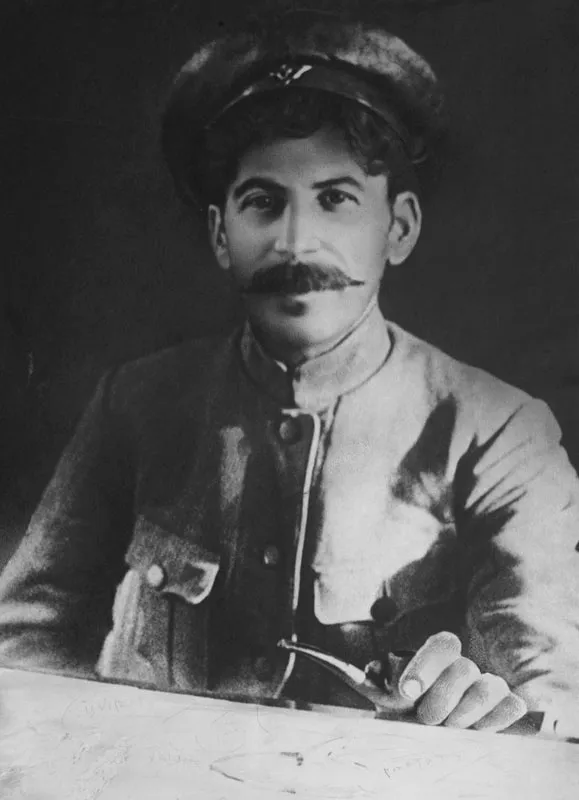
This is a test
- English
- ePUB (mobile friendly)
- Available on iOS & Android
eBook - ePub
The Russian Revolution: History in an Hour
Book details
Book preview
Table of contents
Citations
About This Book
Love history? Know your stuff with History in an Hour.
Frequently asked questions
At the moment all of our mobile-responsive ePub books are available to download via the app. Most of our PDFs are also available to download and we're working on making the final remaining ones downloadable now. Learn more here.
Both plans give you full access to the library and all of Perlego’s features. The only differences are the price and subscription period: With the annual plan you’ll save around 30% compared to 12 months on the monthly plan.
We are an online textbook subscription service, where you can get access to an entire online library for less than the price of a single book per month. With over 1 million books across 1000+ topics, we’ve got you covered! Learn more here.
Look out for the read-aloud symbol on your next book to see if you can listen to it. The read-aloud tool reads text aloud for you, highlighting the text as it is being read. You can pause it, speed it up and slow it down. Learn more here.
Yes, you can access The Russian Revolution: History in an Hour by Rupert Colley in PDF and/or ePUB format, as well as other popular books in Geschichte & Russische Geschichte. We have over one million books available in our catalogue for you to explore.
Information
Topic
GeschichteSubtopic
Russische GeschichteAppendix 1: Key Players
Vladimir Lenin 1870–1924
Lenin was born Vladimir Ilyich Ulyanov on 22 April 1870 in the town of Simbirsk (renamed Ulyanovsk in Lenin’s honour following his death in 1924). The third of six children, Lenin was born into a middle-class family, his father being an inspector of primary schools, a fact Lenin never tried to hide.

Vladimir Lenin, 1895
In 1887, Lenin’s older brother, 21-year-old Alexander Ulyanov, was involved in an attempt to assassinate the Tsar, Alexander III, for which in May 1887, he was hanged. The event shocked the seventeen-year-old Lenin and certainly radicalized him. As the brother of an executed terrorist, Lenin was kept under police surveillance as he took his place to study law at Kazan University in Tatarstan. While at university, Lenin became involved in politics and, after one student riot, was arrested. One of the arresting officers asked him ‘Why are you rebelling, young man? After all, there is a wall in front of you,’ to which Lenin replied, ‘The wall is tottering, you only have to push it for it to fall over.’
Expelled from Kazan University, Lenin continued his studies independently before being allowed to finish his law degree in 1892 at the University of St Petersburg, obtaining a First Class degree and learning to speak Latin and Ancient Greek. For eighteen months, between 1891 and 1893, Lenin worked as a lawyer defending petty thieves, cases he invariably lost. His only success in the courts came sixteen years later when he successfully sued a French nobleman for knocking him off a bicycle near Paris in 1909. Moving to St Petersburg in 1893, Lenin became increasingly involved with revolutionary activity and there, two years later, formed a group, the League of the Struggle for the Emancipation of the Working Class. In 1895, Lenin was arrested and imprisoned for fourteen months in solitary confinement.
In 1897, he was exiled to eastern Siberia where he took the alias Lenin, reportedly influenced by the Siberian River Lena. While in exile, in July 1898, he married fellow revolutionary, Nadezhda Krupskaya. They may have been Marxists and committed atheists but, on the insistence of Krupskaya’s mother, the pair married according to the Orthodox faith.
Following his exile, Lenin wrote his influential What Is To Be Done? and was instrumental in splitting the Russian Social Democratic Labour Party between the Bolsheviks and the Mensheviks. Lenin and his wife lived in Munich, London, and Geneva before returning to Russia in November 1905, towards the end of the 1905 Russian Revolution. Two years later, Lenin returned to exile and would not step on Russian soil again until almost a decade later in April 1917. Much of this time was spent in Switzerland where, as well as writing and guiding the direction of the revolution from afar, he found time to indulge his many hobbies. Lenin and Krupskaya became ardent hill walkers of the Swiss Alps and Lenin enjoyed swimming, cycling, music, skating, and chess.
Krupskaya was unable to have children and is believed to have suffered from Graves’ disease, which can affect fertility. But Lenin’s longstanding affair with Inessa Armand, whom Lenin first met in 1909, probably didn’t help. Krupskaya was prepared to give her husband his freedom but Lenin persuaded her to stay and eventually his wife and mistress became friends. Lenin and Krupskaya, together with Armand, travelled on the sealed train that transported Lenin and his associates back into Russia from Germany. Armand’s death from cholera at the age of forty-four in 1920 greatly grieved Lenin and may have precipitated his own decline.
Lenin’s third stroke, in March 1923, left him paralyzed and unable to speak. Such was the pain experienced by Lenin during his final months, that he begged Stalin to obtain a dose of potassium cyanide to put him out of his misery. He specifically asked Stalin, probably because he knew only Stalin, a man so devoid of any humanity, would be strong enough to do it. But even Stalin baulked at the thought of it and couldn’t bring himself to administer the fatal dose.
Leon Trotsky 1879–1940
Born Lev Bronshtein in the village of Yanovka in the Ukraine, Trotsky, the son of a prosperous Jewish farmer, became involved in politics from a young age. Arrested in 1898, Trotsky was exiled to Siberia where he married and had two daughters, both of whom predeceased him. In 1902, he escaped exile using a forged passport bearing the name Trotsky, the name, he later claimed, of a prison guard he had met in Odessa. He made his way to London where, for the first time, he met Vladimir Lenin and joined the Russian Social Democratic Labour Party. Following the split of the RDSRP, Trotsky’s loyalty floated between the two factions, the Bolsheviks and Mensheviks, often holding a stance of non-allegiance. He opposed Lenin on many issues, a stance that was later held against him.

Leon Trotsky, 1917
The Illustrated London News and Sketch
The Illustrated London News and Sketch
In 1903, Trotsky married for a second time and had two sons. Again, both predeceased him.
Following the outbreak of disturbances throughout Russia in 1905, Trotsky arrived in St Petersburg and there joined its council of workers, or ‘Soviet’, becoming its chair until its forced break-up by tsarist troops in December. Trotsky, along with other leaders, was arrested and again sentenced to exile in Siberia. But en route, he escaped and made his way to London before settling in Vienna where he founded and wrote a newspaper for Russia’s workers, Pravda, ‘Truth’, earning the nickname, ‘the Pen’, for his writing. With the outbreak of war in 1914, Trotsky, as a Russian, was forced to leave Austria. He lived in Paris until, expelled for his anti-war writings, he emigrated to Spain and then New York, arriving in January 1917.
Trotsky returned to Russia and Petrograd in March 1917 and became, in effect, Lenin’s second-in-command as the Bolsheviks overthrew the Provisional Government and set up a new socialist order. In forming the Council of People’s Commissars, Russia’s new government, Lenin appointed Trotsky the People’s Commissar for Foreign Affairs.
Following Russia’s withdrawal from the First World War, Trotsky was appointed War Commissar, responsible for strengthening and injecting much-needed discipline into the Red Army. His use of former officers of the Tsar’s Imperial army caused much disquiet within the Party, Stalin being particularly critical, and was used against him later on.
Trotsky seemed the natural successor to Lenin. In Lenin’s ‘Testament’, he was described as having ‘outstanding ability’ and ‘perhaps the most capable man in the present Central Committee’ but was prone, according to Lenin, to displaying ‘excessive self-assurance’. Trotsky’s succession was blocked by a troika consisting of Stalin, Kamenev, and Zinoviev. Trotsky greatly underestimated Stalin, once referring to him as ‘an excellent bit of mediocrity’.
Following Lenin’s death in January 1924, Stalin ensured he was centre place during the funeral arrangements and the funeral itself. Trotsky had been ill and was recovering in a resort in the Caucasus and Stalin’s telegram to him purposefully gave the wrong date for the funeral.
Trotsky was increasingly marginalized by the Party to the point that, in January 1925, he was relieved of his ministry. Zinoviev and Kamenev, two-thirds of the troika, themselves fell out with Stalin and belatedly joined forces with Trotsky. In October 1927, Trotsky was expelled from the Central Committee and the following month from the Communist Party altogether. In January 1928, Trotsky was exiled to Kazakhstan and finally banished from the Soviet Union altogether in February 1929. After four years in Turkey, two years in France, and two in Norway, Trotsky settled in Mexico in 1937. For a while, he lived in the house of the artist Diego Rivera and, while there, had an affair with Rivera’s artist wife, Frida Kahlo. Meanwhile, Moscow hosted the first of the infamous Show Trials in which old Bolsheviks, such as Lev Kamenev and Grigory Zinoviev, confessed to various anti-State conspiracies and having acted under the instructions of Trotsky. All were sentenced to death, including Trotsky who was found guilty in absentia.
In May 1940, Trotsky survived a raid on his house in Mexico, in which his 25-year-old assistant was murdered, but he was less fortunate three months later. On 20 August, he was attacked at home by an undercover Soviet agent, Ramón Mercader. Fatally wounded by a head wound caused by an ice pick, Trotsky died in hospital the following day.
Joseph Stalin 1878–1953
On 6 December 1878, in Gori, Georgia, was born one of history’s most notorious tyrants, Joseph Vissarionovich Dzhugashvili, better known to history by his adopted name, Stalin, ‘man of steel’. His parents had had three other sons, all of whom died during infancy. At the age of seven, Stalin contracted smallpox. Although he survived it left his face pockmarked, something that he was always self-conscious about. A childhood accident left his left arm shorter than his right and an accident involving a horse-drawn carriage hospitalized the young Stalin for months.

Joseph Stalin, 1918
Stalin’s father, a cobbler, became alcoholic and increasingly abusive towards both his wife and son. Brought up speaking Georgian, Stalin only learnt to speak Russian when aged about nine but he never lost his strong Georgian accent. His mother, a deeply religious woman, enrolled her son into a church school. He graduated to the Tiflis Theological Seminary where, instead of reading his set theological texts, he secretly read the works of Karl Marx. In 1898, Stalin joined the Russian Social Democratic Labour Party and the following year was expelled from the seminary for trying to convert his classmates to Marxism, although his mother claimed he left due to ill health. For a while he worked as a clerk at the Tiflis Meteorological Observatory while becoming involved in organizing strikes, writing articles for socialist newspapers and making revolutionary speeches. During this time he adopted the revolutionary name of Koba.
Between 1902 and 1913, he was arrested six times by the Tsar’s secret police, the Okhrana. Following the split of the Russian Social Democratic Labour Party into two factions – Bolshevik and Menshevik – Stalin, an admirer of the writings o...
Table of contents
- Cover
- Title Page
- About History in an Hour
- Contents
- Introduction
- Emancipation
- Nicholas II: The Last Tsar
- The 1905 Russian Revolution
- The October Manifesto
- War
- February Revolution
- The Provisional Government
- The October Revolution
- Civil War
- Red Terror
- ‘Lenin lived, Lenin lives, and Lenin will live’
- Appendix 1: Key Players
- Appendix 2: Timeline of the Russian Revolution
- Copyright
- Got Another Hour?
- About the Publisher